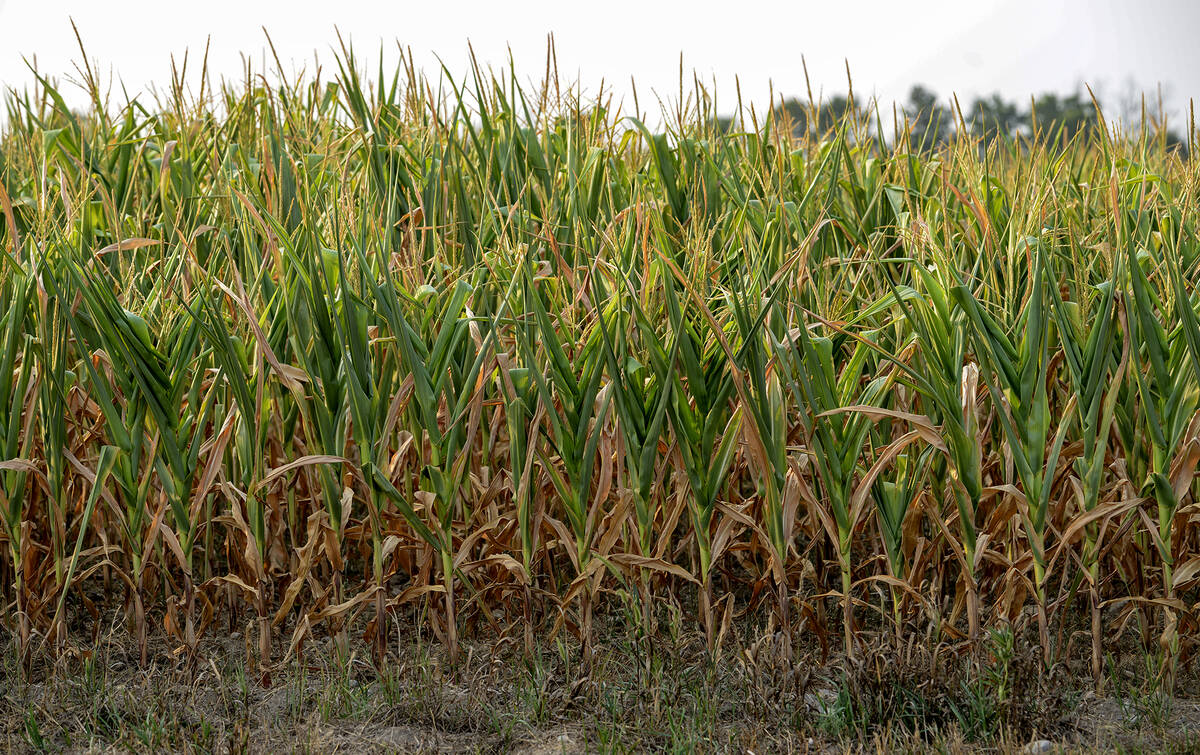Ontario farmers are cautiously optimistic as favourable weather has accelerated crop development. Over the past 30 days, most of the Ontario growing region has received 60 to 85 per cent of normal precipitation along with above normal temperatures.
Quick look
Soybeans: Soybean yields are variable in Ontario, with average down to about 45 bushels per acre.
Corn: Ontario corn exports are down significantly from last year.
Wheat: Low Ontario supply means wheat processors are substituting for soft red wheat.
As of October 21, we estimate that the Ontario soybean crop is 50 per cent harvested and corn progress is estimated at 10 per cent complete. The seven- to 14-day forecast calls for normal to below-normal precipitation along with normal temperatures, which should allow steady progress over the next couple of weeks.
Read Also

Extreme variability marks Ontario’s 2025 corn crop
The yield potential of Ontario’s 2025 corn crop was lost in some areas due to extreme dry conditions.
Compared to October 8, Ontario corn and soybean prices are about 10 cents per bushel higher; soft red winter and hard red winter wheat prices are approximately 30 cents per bu. higher. Hard red spring wheat values are relatively unchanged from two weeks ago.
The wheat market is experiencing a seasonal rally. Corn and soybean markets are absorbing North American harvest pressure.
Relaxed trade tensions between the United States and China have been supportive for the soybean complex. White House economic adviser Larry Kudlow told Fox News that if negotiations with China go well, the planned tariffs scheduled to be implemented on December 15 may be eliminated. Both sides have released positive media releases. Traders have taken a “wait and see” approach because of previous failings.
The Canadian dollar has been percolating higher. Canadian jobs data for September came in better than expected while inflation remains near the Bank of Canada’s target of two per cent. Bank governor Stephen Poloz is not expected to adjust the bank’s short-term interest rate until the first quarter of 2020. U.S. Federal Reserve chair Powell is expected to lower its lending rate by 25 basis points at the end of October. This environment favours further strengthening of the resource-based currency.
Soybeans
Soybean yield reports are quite variable and we’ve made a minor downward adjustment to our average yield projection. We’re now estimating Ontario soybean yields at 45 bu. per acre, down from last year’s yield of 51.4 bu. per acre. This would result in a crop size of 3.8 million tonnes, down from our previous estimate of four million tonnes and down from the 2018 output of 4.2 million tonnes.
The USDA World Agricultural Supply and Demand Estimates (WASDE) report was considered constructive for the soybean complex because the yield was taken down one bushel per acre from the September report. There was also a minor downward revision to harvested area. U.S. soybean production is now estimated at 96.2 million tonnes, down from the September estimate of 98.9 million tonnes and sharply lower than the 2018 output of 120. 5 million tonnes. No major adjustments were made to the demand projections.
The USDA is now projecting the 2019-20 U.S. soybean carryout to finish near 12.5 million tonnes, down from the 2018-19 ending stocks of 24.8 million tonnes. The U.S. soybean crop was 46 per cent harvested as of Oct. 20, down from 51 per cent last year and down from the five-year average of 64 per cent.
Seeding is progressing across Argentina and Brazil and there are no major crop concerns. Brazil has been on the drier side but timely rains are in the forecast. Brazilian soybean production is expected to reach 123 million tonnes, up five million tonnes from 2018-19; Argentina production is projected at 53 million tonnes, unchanged from last year.
What to do: Elevator soybean bids in Ontario are in the range of $11.40 to $11.60, which is up 40 to 60 cents per bu. from last month. In the previous issue, we advised farmers to be 30 to 40 per cent sold. After this week, we’re increasing the recommendation and advising farmers to be 50 per cent sold on their 2019 production. These are the highest bids we’ve seen since last March and we want to be selling into this strength.
Corn
The Ontario corn harvest is in the early stages and we haven’t heard many yield reports. Our crop estimate is unchanged from the previous issue at nine million tonnes, up from the 2018 crop of 8.8 million tonnes. Ontario corn prices are softening due to soft export and domestic demand.
Crop year-to-date corn exports for the week ending October 13 were only 12,500 tonnes, compared to 270,800 tonnes last year.
Ontario cattle on feed inventories are at seasonal lows and will only increase later in winter.
Ethanol margins have improved allowing processors to pay a small premium over elevator bids.
U.S. farmers had harvested 30 per cent of the corn crop as of October 20, which is down from 48 per cent last year and down from the five-year average progress of 47 per cent. Earlier in fall, the corn futures incorporated a small weather premium due to the harvest uncertainty; we now find this weather premium eroding.
The USDA estimated the corn crop at 350 million tonnes on the October WASDE report, relatively unchanged from last month but down from the 2018 production of 366.3 million.
Despite the year-over-year decrease in production, the market is suffering due to the lack of demand.
As of October 11, total U.S. export sales commitments were 10.4 million tonnes, down from 21.088 million tonnes last year. U.S. corn sales commitments are down 51 per cent from last year for the same timeframe. FOB U.S. corn offers out of the Gulf of Mexico for December are 53 cents over the December corn futures. Brazilian corn is offered at 48 cents over the December futures, while Argentina is only 11 cents over the December futures. This explains the slow export pace. Limited export demand and harvest pressure will continue to set a negative tone for the corn market.
What to do: We’ve advised Ontario farmers to be 30 per cent sold on their 2019 corn crop. The market usually experiences a small rally after the U.S. corn harvest is complete. Secondly, export demand will improve later in winter. We’re also watching conditions in Argentina and Brazil. The corn market will be very sensitive to South American production because these two countries have dominated export markets. We’re planning on making our next sales recommendation in December. Be patient in the short-term.
Wheat
The Northern Hemisphere wheat harvest is in the final stages. During this phase of the crop year, production in major exporting countries is known and the focus turns to demand. Farmer selling typically slows down in the U.S., Europe and Russia and export offers from major exporters tend to ratchet higher. The wheat complex has some breathing room until the Australian and Argentine crops come on the market later in December.
In previous articles, we mentioned that the soft red market in the U.S. and Ontario was contending with a tight fundamental structure. This would cause Ontario soft red winter wheat to trade at a premium to world values, which would temper export movement. We’ve now seen the market accomplish this function to ration demand. North American and foreign customers are substituting soft red winter with other types of wheat.
What to do: December Chicago wheat futures dipped to a low of $4.50 on September 3. On October 21, the December contract made a seasonal high of $5.35. Ontario elevator bids for soft red winter wheat are hovering around $6.90/bu.; hard red winter bids are more than $7/bu., while hard red spring wheat bids are also around $6.90/bu. Cash winter wheat prices are up about 50 cents per bushel from September lows. We’re advising producers to sell 20 per cent of their 2019 milling wheat production bringing total sales to 50 per cent.













